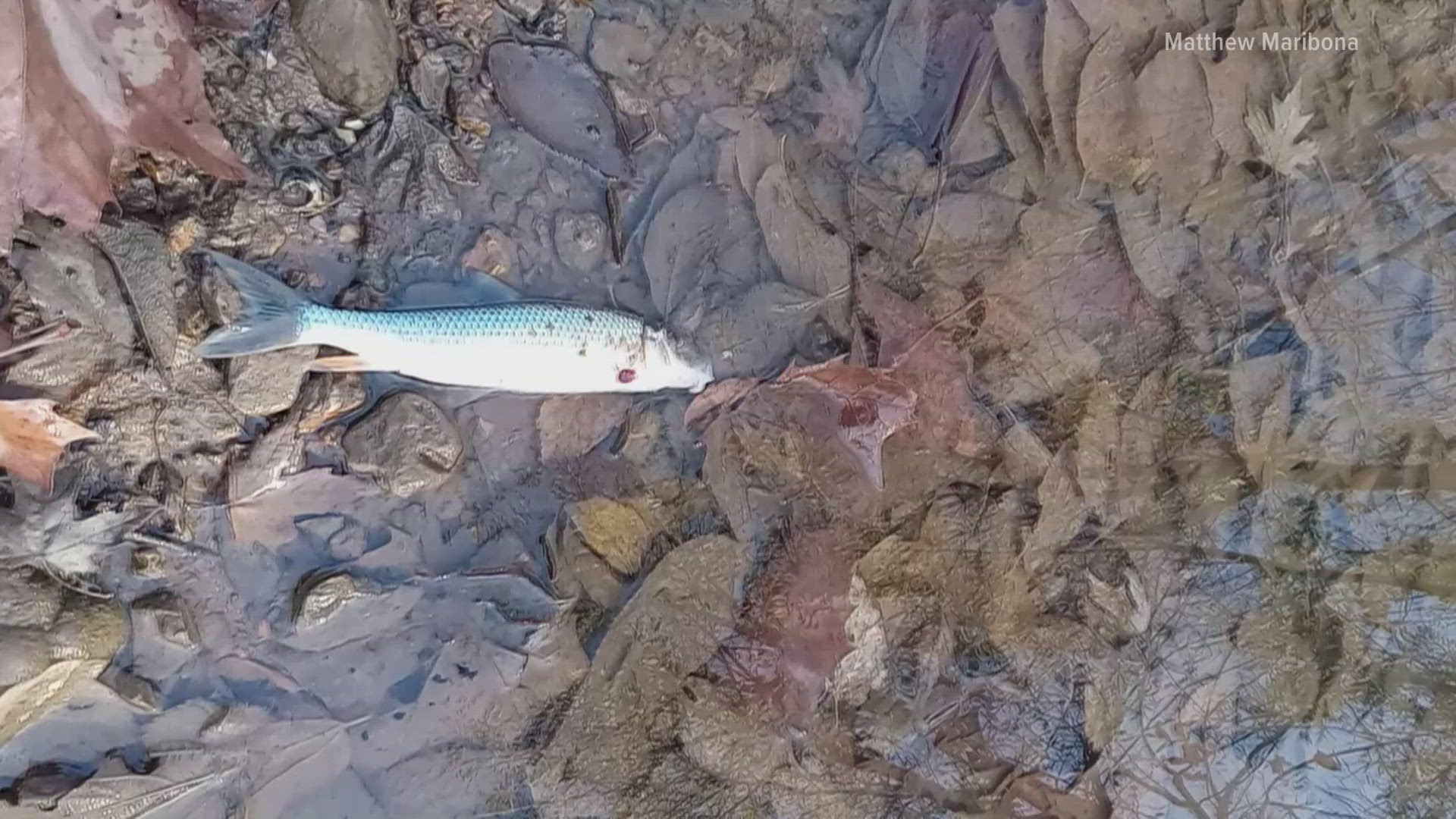FREDERICKTOWN, Mo. — Fredericktown is reeling from the fallout of a massive fire at a lithium-ion battery recycling plant, and the community wants answers.
The fire at Critical Mineral Recovery forced evacuations, raised pollution concerns and has many residents asking hard questions about accountability.
Matthew Maribona, a Fredericktown resident, saw the smoke from the fire heading straight toward his parents’ house. Days after the incident, he ventured to nearby Village Creek and the Little St. Francis River. What he found was chilling: thousands of dead fish floating to the surface.
“It's almost sickening in a way because I grew up in these rivers. I grew up fishing and swimming in these streams," he said. "I am very concerned mostly for the residents and the impact on the wildlife.”
The Missouri Department of Natural Resources, U.S. Fish and Wildlife Service and other agencies are investigating if firefighting foam used to control the blaze could be partly to blame. It’s known to deplete oxygen in water.
Maribona wants tighter regulations.
“It absolutely needs a change because no matter what, we will feel the repercussions of this for years to come," Maribona said.
Al Watkins, an attorney representing Critical Mineral Recovery's parent company Interco, said officials responding to the battery plant explosion believe that the dead fish likely stem from either the temporary effects of firefighting foam or pre-existing heavy metal contamination in the area, unrelated to the recent fire.
"The preliminary finding is the fire resulted from the milling of cathode foil and was noted by CMR personnel on the screener portion of the processing line. There are more issues being addressed with respect to the detection and suppression of the cathode foil fire which was located in an isolated portion of the CMR facility," Watkins wrote in an email.
Watkins said lithium-ion batteries are “inherently dangerous by their very nature," claiming the company’s strong safety protocols kept this fire from becoming a much larger disaster.
“No one was injured, no hospitalization," he said.
The stakes are high as demand for lithium-ion batteries surges, powering everything from cell phones to electric vehicles.
Fires involving lithium-ion batteries are far from isolated. In June, a battery plant explosion in South Korea killed nearly two dozen people. And similar incidents have erupted across the U.S. from San Diego to St. Louis.
The U.S. Consumer Product Safety Commission recalled around 5 million units of consumer products, largely due to lithium-ion battery safety issues, from 2018-2022.
Lindsey Applegate, a chemist at Webster University, said the risks run deeper than what’s visible.
“I wish that people would be a little more careful about our environment and about how we dispose of things, and think about the new technologies that we're building. I think because it is relatively new, there might still be a lack of awareness just in the regular society," Applegate said.
Kevin Jones, a public information officer for the Fredericktown Fire Department, said even one week later, firefighters are still hard at work.
“They do have some heavy machinery there today to remove some of the collapsed portion of the building to access some of the trapped areas of fire. We're definitely making progress," Jones said.
For Maribona, the impact of lithium-ion batteries and technology’s unintended consequences has hit home.
“It is the responsibility of even the town and the specific counties and wherever these places will be to lay these rules down and instate these safety features," Maribona said. “We will feel the repercussions of this for years to come."
Onsite officials at the battery recycling plant have yet to determine what caused the fish kill. Right now, the Missouri DNR is testing surface water samples. The EPA is monitoring air quality.
As lithium-ion battery use and associated dangers rise, some people are questioning if enough is being done to hold companies accountable and protect communities.
“For surface water, CMR’s private contractors and (the Missouri DNR) are taking separate surface water samples to identify and verify possible water quality concerns. The samples will be tested for a wide variety of potential contaminants, such as metals and volatile organic compounds (VOCs), and other impacts, such as pH and dissolved oxygen," the Missouri DNR said in a statement.
"Also for surface water, (the Missouri DNR) is sampling water running from the site, including storm runoff during recent rains. The sampling will be conducted at tributaries to and include Village Creek and Little St. Francois River. The sampling includes total recoverable metals, pH, dissolved oxygen, temperature, biochemical oxygen demand, chemical oxygen demand and VOCs.
"Responding agencies will initiate mitigation action plans to address any water quality concerns that are identified through ongoing testing. Note that with so many samples being taken and the time it takes to test the samples, it could take from a few days to a number of weeks before we receive meaningful sample data. That information will be shared when it becomes available.”
Brian O'Connor, a senior engineer with the National Fire Protection Association, said that as the exponential growth and use of lithium-ion batteries continues, fires similar to the one in Fredericktown could happen more frequently.
O'Connor said the battery recycling plant fire highlights the importance of providing emergency responders with the training and equipment needed to respond to similar incidents safely and effectively.

